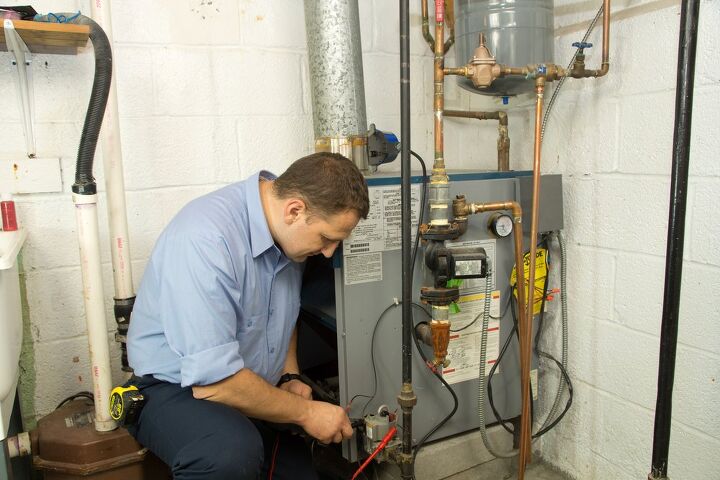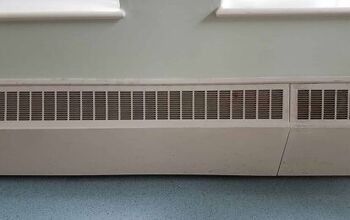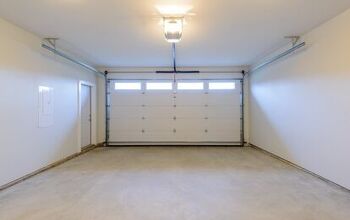Furnace Won't Turn Off? (Possible Causes & Fixes)

As a homeowner, you’re already used to dealing with repairs and maintenance projects throughout your home. That said, it should come as no surprise that issues can arise with your furnace, too. A furnace can be a life saver during the cold winter months, which is why it’s important to ensure it is working properly. That means you can count on it to blow hot air through your home when you need it and to shut off when you don’t. So, what should you do if the furnace won’t turn off at all?
If your furnace won’t turn off, you should look at the thermostat, the air filters, stuck buttons/switches, leaking air ducts, a faulty blower motor, or issues with the electrical sensors. It’s crucial to fix a furnace that won’t turn off immediately, not only because it can make your home uncomfortable but also because it poses a serious fire risk.
Without a functioning furnace, things can easily get too hot to handle at home. This guide will help you learn how to troubleshoot the issue quickly and effectively. That way, you can decide if you can fix it yourself or call in an expert. In this article, we’ll be talking about troubleshooting your:
- Thermostat
- HVAC System
- Electrical Sensors
We’ll also briefly go over the problems with constantly running your furnace and how much repairs will usually cost you. Let’s dive in, so you can get your furnace back in action right away.
Do You Need Furnace or Heating System Repair?
Get free, zero-commitment quotes from pro contractors near you.

Thermostat Issues
The simplest problem that can arise with your furnace starts with the thermostat. So, that’s the first place you should check. You should be able to fix your furnace problem on your own if your thermostat is causing the issue. Here’s what to look out for and how to fix it:
- First, check if someone in your home has turned up the heat on the thermostat. It’s not uncommon for kids—or even grown adults—to fiddle with the thermostat without saying anything. Live alone? Well, things get a little more complicated…
- If your thermostat is set properly, check the temperature outside. If your thermostat is set at a temperature that is warmer than the ambient temperature outside, your furnace could just be doing its job.
- Turn your thermostat’s fan to AUTO. Turning the fan to AUTO will allow the fan to turn off once your home has reached the temperature at the set point. If it continues blowing once it reaches that temperature, there is a deeper issue happening.
- Finally, you should check the wiring of your thermostat. If your wiring is frayed or otherwise damaged, you might have a faulty thermostat to blame for your furnace problems. This can be treated by replacing your thermostat or fixing the wiring. At this point, you’ll most likely want to call in an electrician or HVAC contractor.
HVAC System Issues
Once you’ve ruled out the thermostat as the culprit, it’s time to take a look into the different parts of your HVAC system. This includes the air filter, the buttons and switches on your furnace, the air ducts, and the blower motor. Here’s what you need to do for each.
Dirty Furnace Air Filter
In most cases, the fastest way to make sure that your furnace and HVAC system starts working well once more is to clean or switch out the air filter. Many professionals find that a dirty furnace filter is the top cause for furnaces that run constantly.
When your furnace turns on, it starts pulling air from your home into the ducts to heat it. The air filter is responsible for trapping dust, debris, and even pet hair that can potentially damage the furnace and prevents it from getting into the heat exchanger.
When the filter is dirty, it impedes airflow in your HVAC system. This, in turn, can “trick” your furnace into staying on regardless of how warm it already is in your home. It can also cause your furnace to overheat, which will shift the unit into “cool down” mode and continuously run the fan. In some cases, the furnace may even begin blowing cold air.
Even if this isn’t the cause of your furnace issues, you should regularly replace the filter. Clean filters will improve your home’s energy efficiency and will also prevent your HVAC system from overheating in the future. Plus, replacing your filters is affordable and easy.
If your filter is exceptionally dirty, you should take it out immediately even if you don’t have a clean one to replace it immediately. You can technically run your furnace without a filter, but only for a short period of time.
Stuck Buttons and Switches
Before you panic and call the HVAC crews, go to your furnace and take a look at all the buttons and switches on it. If you have any switches that are pressed down, particularly those dealing with heating, try to push them upwards to see if it helps. Sometimes, buttons that are stuck on a “down” setting can be a reason why your furnace is still constantly turned on.
The good news is you can fix this issue on your own. First, turn off the furnace completely. This means shutting off the electricity running to it and the gas as well. After that, all you have to do is use your fingers or pliers to carefully pull the button back up.
It’s important to know this is a temporary fix. If any buttons or switches are causing problems with your furnace, you should eventually replace them altogether.
Leaking Air Duct
Your ductwork is a crucial system that delivers air throughout your home. Over time, the air ducts can degrade and eventually end up with holes. When you have a hole in your air duct, all the hot air that should be blowing through your vents will escape.
Depending on where the holes are, the heat could be leaking into the inside of your walls rather than your home’s livable interior. A solid sign that your air ducts have a leak is if you notice temperature fluctuations between rooms in your home or warm air not reaching rooms at all.
The problem with air duct leaks is that you can’t always see them yourself. After all, ducts tend to be behind walls and in hard-to-reach attics or crawlspaces. If you are concerned about a duct leak, your best bet is to hire an HVAC tech to find it and patch it up.
Broken Furnace Blower Motor
We’ll be frank here. A bad blower switch is one of the worst things that can happen to your HVAC system. Your furnace blower motor is what blows the hot air to the various rooms in your home. The switch is what controls it, turning it off and on via signals.
If the motor switch is bad, it may become a fairly pricey problem. Trying to fix a blower motor on your own without any professional knowledge will most likely make the problem worse, so be sure to call a technician right away. They will be able to either install a new switch or repair the wiring on the existing blower motor switch.
If you are unsure whether or not your furnace blower is bad, the easiest way to tell is if your furnace keeps blowing cold air. This suggests that you have a switch that can’t sense heat properly and could be forcing the furnace to stay on, even when you don’t want stuff fanning around.
Electrical Issues
If you have gone through every other potential fix on this list and still haven’t found the root of the problem, the electrical sensors may be involved. Though this is a rare instance, it can happen to the best of furnaces.
This issue stems from electrical sensors that aren’t properly registering heat or timing. When this happens, the electric components of the furnace aren’t actually capable of picking up on the warning signs of an overheating furnace.
This, in turn, turns your furnace into a fire hazard. That’s why it is so important to resolve the issue as quickly as possible. If you cannot diagnose the furnace problem yourself, the best thing you can do is to call a repairman.
Why Your Furnace Shouldn’t Always be Running
Your furnace should not be running on a constant basis. The length of your furnace’s heating cycle can vary based on a number of factors, including the temperature outside and the temperature at which you set your thermostat.
That said, the average run time for a furnace is between 10 and 15 minutes a cycle. If your home has average insulation, your furnace may typically need to run between two or three times per hour to maintain the desired temperature in your home.
If you find that you need your furnace turned on constantly to keep your home warm, you may have some underlying efficiency issues that makes a call to an HVAC repair company worth it.
A furnace that won’t turn off might seem like just a nuisance, but it can actually be dangerous. In some cases, a it won’t be able to utilize its emergency shutoff in the event of overheating. This can lead to a house fire or even an explosion. That’s why it’s so important to address this issue as soon as you notice it.
Furnace Lifespan & Repairs
If maintained well, you should expect a gas furnace to last for approximately 15 to 20 years. An electric furnace typically has a longer lifespan, ranging from 20 and 30 years. Some furnaces can last over 40 years, though this is not something you should expect.
To get a better idea of your furnace’s lifespan, take a look at the warranty and current lifespan notes online. The longer the warranty, the more durable the furnace tends to be.
The cost to repair your furnace can vary greatly depending on what is wrong with it. A typical HVAC repair will start with a $50 to $100 inspection fee. The total costs of the repairs, including parts and labor, usually ranges from $300 to $450.
Do You Need Furnace or Heating System Repair?
Get free, zero-commitment quotes from pro contractors near you.

Final Thoughts on What to Do When Your Furnace Won’t Turn Off
There can be a handful of different causes for why your furnace won’t turn off, and it’s important to figure it out as quickly as possible. Before you call in a professional, try to pinpoint the issue yourself.
If the problem is from your thermostat being set at the wrong temperature, a dirty air filter, or stuck buttons, you can most likely fix it on your own. On the other hand, a professional should handle bigger issues like a broken blower motor, leaking air ducts, or electrical malfunctions.
Either way, there’s a good chance you can at least figure out where the issue is originating. Hopefully, this guide can help you with that process!

Ossiana Tepfenhart is an expert writer, focusing on interior design and general home tips. Writing is her life, and it's what she does best. Her interests include art and real estate investments.
More by Ossiana Tepfenhart



























